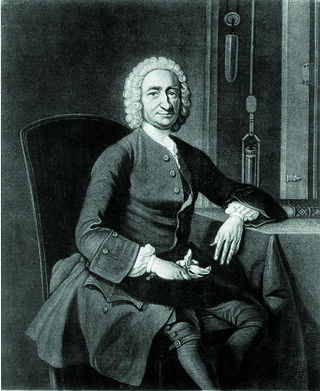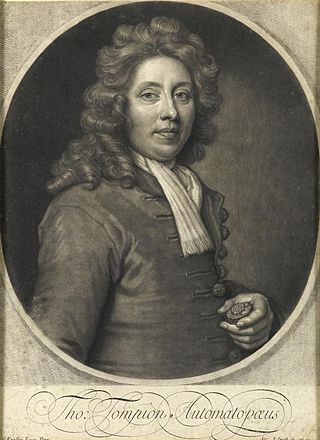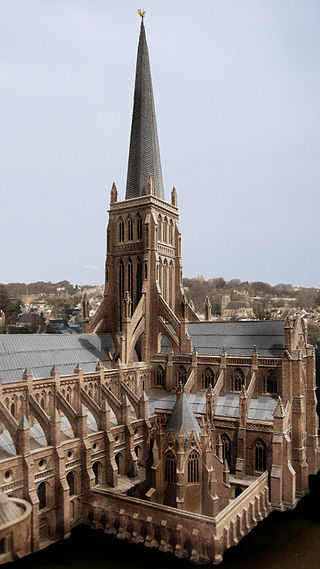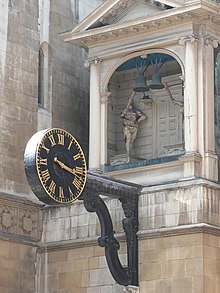
Fleet Street is a major street mostly in the City of London, England. It runs west to east from Temple Bar at the boundary with the City of Westminster to Ludgate Circus at the site of the London Wall and the River Fleet from which the street was named.

The Worshipful Company of Clockmakers was established under a royal charter granted by King Charles I in 1631. It ranks sixty-first among the livery companies of the City of London, and comes under the jurisdiction of the Privy Council. The company established a library and its museum in 1813, which is the oldest specific collection of clocks and watches worldwide. This is administered by the company's affiliated charity, the Clockmakers' Charity, and is presently housed on the second floor of London's Science Museum. The modern aims of the company and its museum are charitable and educational, in particular to promote and preserve clockmaking and watchmaking, which as of 2019 were added to the HCA Red List of Endangered Crafts.

A watchmaker is an artisan who makes and repairs watches. Since a majority of watches are now factory-made, most modern watchmakers only repair watches. However, originally they were master craftsmen who built watches, including all their parts, by hand. Modern watchmakers, when required to repair older watches, for which replacement parts may not be available, must have fabrication skills, and can typically manufacture replacements for many of the parts found in a watch. The term clockmaker refers to an equivalent occupation specializing in clocks.

A clockmaker is an artisan who makes and/or repairs clocks. Since almost all clocks are now factory-made, most modern clockmakers only repair clocks. Modern clockmakers may be employed by jewellers, antique shops, and places devoted strictly to repairing clocks and watches. Clockmakers must be able to read blueprints and instructions for numerous types of clocks and time pieces that vary from antique clocks to modern time pieces in order to fix and make clocks or watches. The trade requires fine motor coordination as clockmakers must frequently work on devices with small gears and fine machinery.

George Graham, FRS was an English clockmaker, inventor, and geophysicist, and a Fellow of the Royal Society.

St Bartholomew the Less is an Anglican church in the City of London, associated with St Bartholomew's Hospital, within whose precincts it stands. Once a parish church, it has, since 1 June 2015, been a chapel of ease in the parish of St Bartholomew the Great.

The Guild Church of St Mary Aldermary, a contraction of St Mary Aldermanbury, is an Anglican church located in Watling Street at the junction with Bow Lane, in the City of London. Of medieval origin, it was rebuilt from 1510 - 1632. Badly damaged in the Great Fire of London in 1666, it was rebuilt once more, this time by Sir Christopher Wren; unlike the vast majority of Wren's City churches, St Mary Aldermary is in the Gothic style.

The Clockmakers’ Museum in London, England, is believed to be the oldest collection specifically of clocks and watches in the world. The collection belongs to and is administered by the Clockmakers’ Charity, affiliated to the Worshipful Company of Clockmakers, founded in 1631 by Royal Charter. Since 2015 it has been housed in a gallery provided by the Science Museum in South Kensington, having formerly been located in the Guildhall complex in the City of London since 1874, where it first opened to the public. Admission is free.
John Shaw Sr. (1776–1832) was an English architect. He was architect to Christ's Hospital in London, and to the Port of Ramsgate. Many of his works, including the church of St Dunstan-in-the-West in Fleet Street, London, were in a Gothic Revival style.

Thomas Tompion, FRS (1639–1713) was an English clockmaker, watchmaker and mechanician who is still regarded to this day as the "Father of English Clockmaking". Tompion's work includes some of the most historic and important clocks and watches in the world, and can command very high prices whenever outstanding examples appear at auction. A plaque commemorates the house he shared on Fleet Street in London with his equally famous pupil and successor George Graham.

Old St Paul's Cathedral was the cathedral of the City of London that, until the Great Fire of 1666, stood on the site of the present St Paul's Cathedral. Built from 1087 to 1314 and dedicated to Saint Paul, this building was perhaps the fourth such church at this site on Ludgate Hill, going back to the 7th century.

St Antholin, Budge Row, or St Antholin, Watling Street, was a church in the City of London. Of medieval origin, it was rebuilt to the designs of Sir Christopher Wren, following its destruction in the Great Fire of London in 1666. The 17th-century building was demolished in 1874.

Thomas Mudge was an English horologist who invented the lever escapement, a technological improvement to the pocket watch.

Joseph Knibb (1640–1711) was an English clockmaker of the Restoration era. According to author Herbert Cescinsky, a leading authority on English clocks, Knibb, "next to Tompion, must be regarded as the greatest horologist of his time."
Edward East (1602–1696) was watchmaker and clockmaker to King Charles I of England. He was a notable horologist who succeeded David Ramsay. East was trained as a goldsmith, and he was a founding member of the London Clockmakers Company in 1631.
Charles Gretton was an English clock and watchmaker during the golden age of English clockmaking.
George Etherington was a clockmaker and watchmaker operating in London in the last quarter of the 17th century and the first quarter of the 18th century.

John Tolson (1691–1737) was an important if elusive English clockmaker and watchmaker of the early eighteenth century who, while not particularly remarkable for his invention, is noteworthy because of the fine quality of his clocks and watches. The style of his early longcase clocks owes much to Thomas Tompion, and the delicate functionality of his early longcase wheelwork echoes Tompion's standards. His short career of 22 years before an early death in 1737 makes his clocks and watches relatively rare and they can command high prices whenever outstanding examples appear at auction.

Joshua Marshall (1628–1678) was a 17th century English mason and sculptor. As the King's Master Mason at the time of the Great Fire of London he was responsible for many of the rebuilding projects and worked closely with Christopher Wren and was the builder of several "Wren churches".























